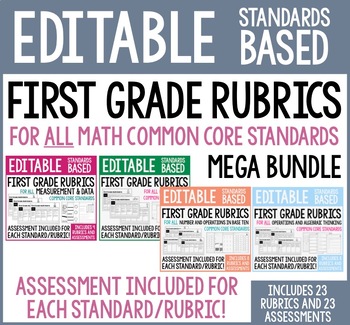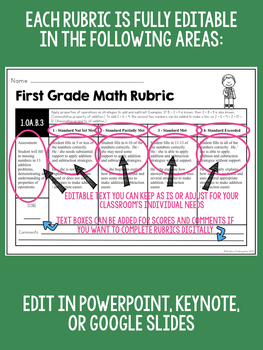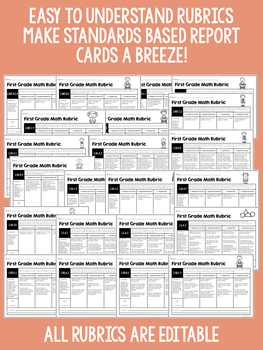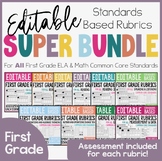Editable Standards Based Rubrics & Assessments for ALL 1st Grade Math Standards
- Zip
Products in this Bundle (4)
Also included in
- This is a mega bundle of all my English Language Arts and Math Common Core Rubrics and Assessments packs for first grade.It includes every thing you need to assess, record, and report student success for every single first grade language arts and math Common Core standard using a standards-based repPrice $24.99Original Price $37.90Save $12.91
Description
This is a bundle of all 4 of my Math Common Core Rubrics and Assessments packs for first grade. It includes every thing you need to assess, record, and report student success for every single first grade math Common Core standard using standards-based report card.
All rubrics are EDITABLE in Powerpoint, Keynote, and Google Slides. PDFs of all rubrics and assessments are also included. Easily change each rubric to fit your unique classroom needs!
Included in This Bundle:
Operations and Algebriac Thinking Packet:
4 EDITABLE Rubrics that Correspond with the Following Included Assessments:
1.MD.A.1: Student will compare the lengths of 3 objects. Student will determine which of two lines is longer, using a third object to measure. There are 7 tasks in the assessment.
1.MD.A.2: Student will choose a unit (such as cubes, paperclips, or base ten blocks) to measure 5 lines and record their measurements.
1.MD.B.3: Student will write the times shown (to the hour and half hour) on six analog clocks. Given the time, the student will draw the matching hands on three clocks.
1.MD.C.4: Student will use given data to fill in a bar graph and answer and ask questions about the graph. There are 7 total tasks on the assessment.
Number and Operations in Base 10 Packet:
8 EDITABLE Rubrics that Correspond with the Following Included Assessments:
1.NBT.A.1: Student will write the ten numbers that come next for 4 numbers (1, 25, 99, 110). They will count 5 groups of objects and write the number to show how many.
1.NBT.B.2.A: Student looks at a base ten long and identifies the numbers and phrases that match the long.
1.NBT.B.2.B: Student will use base ten blocks and phrases (for example, one ten and four ones) and match them to the numbers 11-19.
1.NBT.B.2.C: Student will count base ten blocks and write the numbers 10, 20, 30, 40, 50, 60, 70, 80, 90, and 100 to match their counts.
1.NBT.B.3: Student will use. <, >, and = to compare 16 sets of two digit numbers.
1.NBT.C.4: Student will solve 20 addition problems, with sums up to 100.
1.NBT.C.5: Student writes the numbers that are 10 more and 10 less than 17 given two digit numbers and explains how they are able to find the numbers.
1.NBT.C.6: Student will answer 15 subtraction problems containing 2, 2 digit multiples of 10.
Measurement and Data Packet:
4 EDITABLE Rubrics that Correspond with the Following Included Assessments:
1.MD.A.1: Student will compare the lengths of 3 objects. Student will determine which of two lines is longer, using a third object to measure. There are 7 tasks in the assessment.
1.MD.A.2: Student will choose a unit (such as cubes, paperclips, or base ten blocks) to measure 5 lines and record their measurements.
1.MD.B.3: Student will write the times shown (to the hour and half hour) on six analog clocks. Given the time, the student will draw the matching hands on three clocks.
1.MD.C.4: Student will use given data to fill in a bar graph and answer and ask questions about the graph. There are 7 total tasks on the assessment.
Geometry Packet:
3 EDITABLE Rubrics that Correspond with the Following Included Assessments:
1.G.A.1: Student will draw a shape and name its defining and non defining attributes. Student will draw and name shapes with given attributes. There are 18 total tasks on the assessment.
1.G.A.2: Student will cut out 2D shapes and use them to create 3 new composite shapes. Students will use two composite shapes to make a new shape. Student will determine which 3D shapes could be used to make common objects. There a re 13 tasks on the assessment.
1.G.A.3: Student will partition circles into half and fourths and determine which shares are bigger. Student will shade shapes to match given fractions and write names for portions of shapes that are shaded.There are 13 total tasks on the assessment.
How to Use this Resource:
*Once a standard has been taught, use administer the assessment. Use the matching rubric to report student progress.
*All rubrics are editable. You may choose to use the provided text or change it to meet your classroom's individual needs.
*Students will receive a score based on the rubric that can be used for parent / teachers communication, report cards, etc.
*Rubrics (and some of the assessments) can be edited in Keynote, Powerpoint, and Google Slides. PDFs of all sheets are included as well.
You can also find these packets bundled with my first grade language arts rubrics at a discounted price here:
Editable Rubrics and Assessments for ALL 1st Grade Language Arts and Math Common Core Standards
I hope you find this resource helpful. Please message me if you have any questions.
-Kendra
Kendra's Kindergarten






